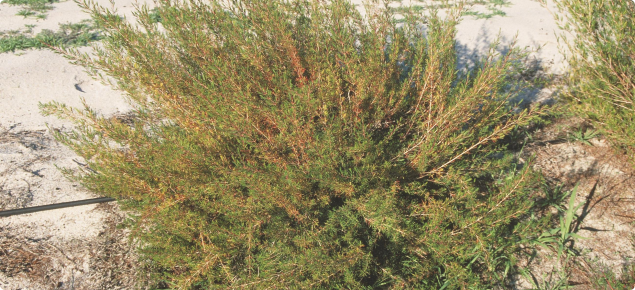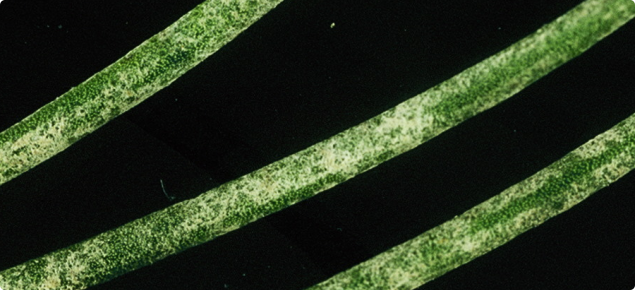Introduction
Growers of waxflowers and other wildflower crops have limited ability to modify the aerial environment, making control of some fungal diseases challenging . Air circulation can be enhanced with the use of windbreaks, by changing plant spacing, and by pruning.
Using drip irrigation or microsprays can keep foliage dry and thereby minimise the spread of aerial spores at certain times of the year, however rainfall is unpredictable and can promote disease. During periods of erratic wet and dry weather it is difficult to maintain protective coatings of fungicide even if initial conditions allowed for spraying.
Botrytis
Botrytis, commonly called grey mould, is a widespread problem both in the field and postharvest.
Flowers are most susceptible. When infected, they can develop pale to tan-coloured lesions depending on flower colour (Figure 1).
Infections usually start in the centre of the flower as the fungus feeds on the nectar. Grey fluffy mycelium and spore masses may also be present, especially under humid conditions. Leaves and stems can also become infected and young shoots infected with Botrytis cinerea may wither and die.
After harvest, usually during transport, Botrytis causes flower drop (Figure 2). Botrytis can also be a problem in cutting propagation due to the humid conditions. Care should be taken to use clean material and follow good hygiene practices in propagation areas.
For flower fall to occur, the pathogen must be present even though it is often symptomless at the time of harvest. Temperature fluctuations in transit allow condensation, providing free moisture in which fungal spores germinate. These fluctuations, combined with high humidity during transport, greatly promote infections. In turn, infected flowers produce ethylene which results in the flower drop in susceptible varieties (Figure 3).
Botrytis spores may lay dormant on plant tissue for some time before germinating when the conditions are right.
Good hygiene is crucial. Removal of any plant debris which could carry disease should be ongoing practice. Studies have shown that one infected leaf exposed to a 45 minute rain shower can infect an area of up to 32 square metres.
There is evidence that mulches that provide an uneven surface (as opposed to weed mat, for example) below plants in the field can be helpful in reducing the dispersal of spores that land on that surface, reducing disease spread.
High relative humidity (more than 93%) and free water at the infection site are necessary for infection. Maintaining significant airflow within the plant canopy can reduce infection rates. Good light penetration into the lower crop canopy maintains leaf health and helps to reduce infection rates.
Field chemical control should aim to minimise the risk of developing fungicide resistance. Rotation between fungicides of different chemical groups is absolutely vital. It has been suggested that one effective chemical (iprodione) be reserved solely for postharvest dipping.
Registrations and permits for chemicals do change and you should refer to the Australian Pesticides and Veterinary Medicines Authority (APVMA) website for current information. Read the chemical label to determine the maximum numbers of applications allowed per season.
In protected environments such as greenhouses, dehumidifiers work well to reduce relative humidity to below 85%. Fans may be used in the early morning to circulate air and prevent condensation on leaves. In the propagation house, night break lighting prevents spore germination. Botrytis spores require four hours of semi-darkness for germination and infection.
In Israel, a decision support system has been developed (BOTMAN, short for Botrytis manager). Table 1 details the scoring system used in trials with greenhouse cucumbers. The likely risk values will probably be different for waxflower. However, the table gives an idea of the weather parameters that growers need to be aware of as a risk for infection.
| Parameter | Parameter range | Assigned severity value |
|---|---|---|
| Rain quantity (mm/day) | 0.0–0.4 | 0.0 |
| 0.5–5.0 | 0.2 | |
| 5.1-10.0 | 0.4 | |
| 10.1–20.0 | 0.6 | |
| 20.1–30.0 | 1.0 | |
| >30.0 | 1.2 | |
| Number of rainy days (>0.5mm/day) | 0 | 0.0 |
| 1 | 0.2 | |
| 2 | 0.4 | |
| 3 | 0.6 | |
| 4 | 1.1 | |
| Maximum temperature (ºC) | <9 | 0.1 |
| 10-21 | 0.3 | |
| 22-26 | 0.1 | |
| >26 | 0.0 | |
| Number of days with 5/8 cloud cover (>6 hours during the day) | 0 | 0.0 |
| 1-2 | 0.2 | |
| 3-4 | 0.5 | |
| Number of days with hot dry weather (<25% relative humidity for more than 4 hours) | 0 | 1.0 |
| 1-2 | 0.5 | |
| 3-34 | 0.0 |
Within each parameter, the severity values for the selected parameter range are added together to give the overall risk for botrytis. Severe disease outbreaks are expected when the risk index is more than 4.6. Moderate disease is expected when the risk index is between 2.5 and 4.5. Slow or no disease progress is expected when the risk index is less than 2.4.







